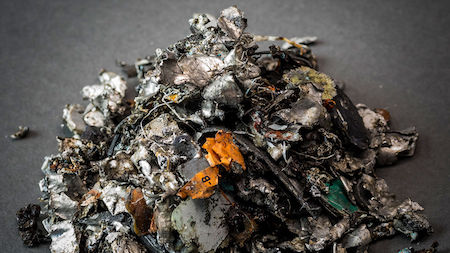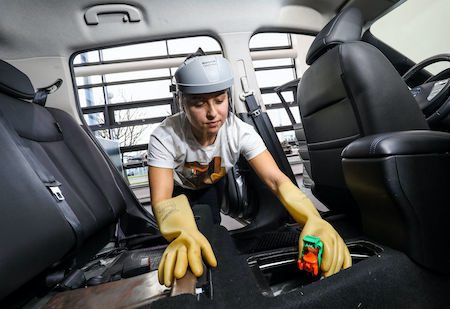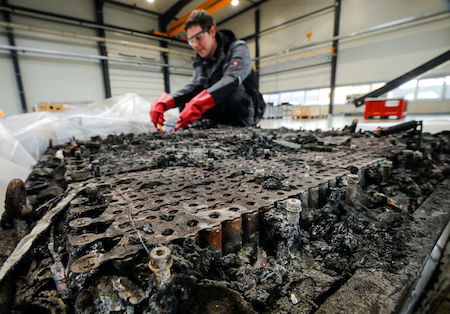Millions of electric cars are coming. What happens to all the dead batteries?
 Print This Print This
By Ian Morse | ScienceMag.org
from Science
Wednesday, May 26, 2021
 |
| A shredded electric vehicle battery can yield recyclable metals, but it is often cheaper for battery makers to use new materials. ARGONNE NATIONAL LABORATORY |
The battery pack of a Tesla Model S is a feat of intricate engineering. Thousands of cylindrical cells with components sourced from around the world transform lithium and electrons into enough energy to propel the car hundreds of kilometers, again and again, without tailpipe emissions. But when the battery comes to the end of its life, its green benefits fade. If it ends up in a landfill, its cells can release problematic toxins, including heavy metals. And recycling the battery can be a hazardous business, warns materials scientist Dana Thompson of the University of Leicester. Cut too deep into a Tesla cell, or in the wrong place, and it can short-circuit, combust, and release toxic fumes.
That’s just one of the many problems confronting researchers, including Thompson, who are trying to tackle an emerging problem: how to recycle the millions of electric vehicle (EV) batteries that manufacturers expect to produce over the next few decades. Current EV batteries “are really not designed to be recycled,” says Thompson, a research fellow at the Faraday Institution, a research center focused on battery issues in the United Kingdom.
That wasn’t much of a problem when EVs were rare. But now the technology is taking off. Several carmakers have said they plan to phase out combustion engines within a few decades, and industry analysts predict at least 145 million EVs will be on the road by 2030, up from just 11 million last year. “People are starting to realize this is an issue,” Thompson says.
Governments are inching toward requiring some level of recycling. In 2018, China imposed new rules aimed at promoting the reuse of EV battery components. The European Union is expected to finalize its first requirements this year. In the United States, the federal government has yet to advance recycling mandates, but several states, including California—the nation’s largest car market—are exploring setting their own rules.
Complying won’t be easy. Batteries differ widely in chemistry and construction, which makes it difficult to create efficient recycling systems. And the cells are often held together with tough glues that make them difficult to take apart. That has contributed to an economic obstacle: It’s often cheaper for batterymakers to buy freshly mined metals than to use recycled materials.
 |
| Materials scientist Dana Thompson develops solvents for extracting valuable metals from spent car batteries. FARADAY INSTITUTION |
Better recycling methods would not only prevent pollution, researchers note, but also help governments boost their economic and national security by increasing supplies of key battery metals that are controlled by one or a few nations. “On the one side, [disposing of EV batteries] is a waste management problem. And on the other side, it’s an opportunity for producing a sustainable secondary stream of critical materials,” says Gavin Harper, a University of Birmingham researcher who studies EV policy issues.
To jump-start recycling, governments and industry are putting money into an array of research initiatives. The U.S. Department of Energy (DOE) has pumped some $15 million into a ReCell Center to coordinate studies by scientists in academia, industry, and at government laboratories. The United Kingdom has backed the ReLiB project, a multi-institution effort. As the EV industry ramps up, the need for progress is becoming urgent, says Linda Gaines, who works on battery recycling at DOE’s Argonne National Laboratory. “The sooner we can get everything moving,” she says, “the better.”
EV BATTERIES are constructed a bit like nested dolls. Typically, a main pack holds several modules, each of which is constructed from numerous smaller cells (see graphic, below). Inside each cell, lithium atoms move through an electrolyte between a graphite anode and a cathode sheet composed of a metal oxide. Batteries are usually defined by the metals in the cathode. There are three main types: nickel-cobalt-aluminum, iron-phosphate, and nickel-manganese-cobalt.
Now, recyclers primarily target metals in the cathode, such as cobalt and nickel, that fetch high prices. (Lithium and graphite are too cheap for recycling to be economical.) But because of the small quantities, the metals are like needles in a haystack: hard to find and recover.
To extract those needles, recyclers rely on two techniques, known as pyrometallurgy and hydrometallurgy. The more common is pyrometallurgy, in which recyclers first mechanically shred the cell and then burn it, leaving a charred mass of plastic, metals, and glues. At that point, they can use several methods to extract the metals, including further burning. “Pyromet is essentially treating the battery as if it were an ore” straight from a mine, Gaines says. Hydrometallurgy, in contrast, involves dunking battery materials in pools of acid, producing a metal-laden soup. Sometimes the two methods are combined.
Each has advantages and downsides. Pyrometallurgy, for example, doesn’t require the recycler to know the battery’s design or composition, or even whether it is completely discharged, in order to move ahead safely. But it is energy intensive. Hydrometallurgy can extract materials not easily obtained through burning, but it can involve chemicals that pose health risks. And recovering the desired elements from the chemical soup can be difficult, although researchers are experimenting with compounds that promise to dissolve certain battery metals but leave others in a solid form, making them easier to recover. For example, Thompson has identified one candidate, a mixture of acids and bases called a deep eutectic solvent, that dissolves everything but nickel.
Both processes produce extensive waste and emit greenhouse gases, studies have found. And the business model can be shaky: Most operations depend on selling recovered cobalt to stay in business, but batterymakers are trying to shift away from that relatively expensive metal. If that happens, recyclers could be left trying to sell piles of “dirt,” says materials scientist Rebecca Ciez of Purdue University.
THE IDEAL is direct recycling, which would keep the cathode mixture intact. That’s attractive to batterymakers because recycled cathodes wouldn’t require heavy processing, Gaines notes (although manufacturers might still have to revitalize cathodes by adding small amounts of lithium). “So if you’re thinking circular economy, [direct recycling] is a smaller circle than pyromet or hydromet.”
In direct recycling, workers would first vacuum away the electrolyte and shred battery cells. Then, they would remove binders with heat or solvents, and use a flotation technique to separate anode and cathode materials. At this point, the cathode material resembles baby powder.
So far, direct recycling experiments have only focused on single cells and yielded just tens of grams of cathode powders. But researchers at the U.S. National Renewable Energy Laboratory have built economic models showing the technique could, if scaled up under the right conditions, be viable in the future.
To realize direct recycling, however, batterymakers, recyclers, and researchers need to sort out a host of issues. One is making sure manufacturers label their batteries, so recyclers know what kind of cell they are dealing with—and whether the cathode metals have any value. Given the rapidly changing battery market, Gaines notes, cathodes manufactured today might not be able to find a future buyer. Recyclers would be “recovering a dinosaur. No one will want the product.”
 |
| A technician in Germany makes sure a burned lithium-ion battery is discharged before further recycling. WOLFGANG RATTAY/REUTERS |
Another challenge is efficiently cracking open EV batteries. Nissan’s rectangular Leaf battery module can take 2 hours to dismantle. Tesla’s cells are unique not only for their cylindrical shape, but also for the almost indestructible polyurethane cement that holds them together.
Engineers might be able to build robots that could speed battery disassembly, but sticky issues remain even after you get inside the cell, researchers note. That’s because more glues are used to hold the anodes, cathodes, and other components in place. One solvent that recyclers use to dissolve cathode binders is so toxic that the European Union has introduced restrictions on its use, and the U.S. Environmental Protection Agency determined last year that it poses an “unreasonable risk” to workers.
“In terms of economics, you’ve got to disassemble … [and] if you want to disassemble, then you’ve got to get rid of glues,” says Andrew Abbott, a chemist at the University of Leicester and Thompson’s adviser.
TO EASE THE PROCESS, Thompson and other researchers are urging EV- and batterymakers to start designing their products with recycling in mind. The ideal battery, Abbott says, would be like a Christmas cracker, a U.K. holiday gift that pops open when the recipient pulls at each end, revealing candy or a message. As an example, he points to the Blade Battery, a lithium ferrophosphate battery released last year by BYD, a Chinese EV-maker. Its pack does away with the module component, instead storing flat cells directly inside. The cells can be removed easily by hand, without fighting with wires and glues.
The Blade Battery emerged after China in 2018 began to make EV manufacturers responsible for ensuring batteries are recycled. The country now recycles more lithium-ion batteries than the rest of the world combined, using mostly pyro- and hydrometallurgical methods.
Nations moving to adopt similar policies face some thorny questions. One, Thompson says, is who should bear primary responsibility for making recycling happen. “Is it my responsibility because I bought [an EV] or is it the manufacturer’s responsibility because they made it and they’re selling it?”
In the European Union, one answer could come later this year, when officials release the continent’s first rule. And next year a panel of experts created by the state of California is expected to weigh in with recommendations that could have a big influence over any U.S. policy.
Recycling researchers, meanwhile, say effective battery recycling will require more than just technological advances. The high cost of transporting combustible items long distances or across borders can discourage recycling. As a result, placing recycling centers in the right places could have a “massive impact,” Harper says. “But there’s going to be a real challenge in systems integration and bringing all these different bits of research together.”
There’s little time to waste, Abbott says. “What you don’t want is 10 years’ worth of production of a cell that is absolutely impossible to pull apart,” he says. “It’s not happening yet—but people are shouting and worried it will happen.”
Source URL
|
 Print This Print This

|

